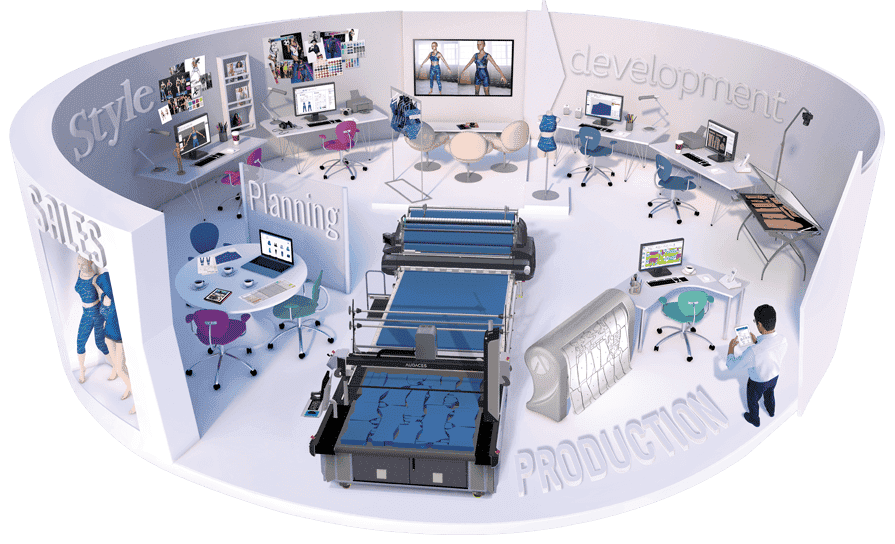Summary
- Fashion houses play a crucial role in setting high-quality standards in the industry.
- By embracing technology, it is possible to optimize processes while preserving the rich heritage.
- Discover how Audaces360 solutions can help you. Start your free trial today!
The conflict between the traditional and the modern exists in all artistic areas, and fashion is no exception. This healthy difference fosters creativity and enriches the industry.
Admirers of fashion houses and traditional brands stand for their legacy and the synonymous high quality and exclusivity they represent.
Meanwhile, those who embrace modernity believe in making fashion more accessible and breaking the mold through innovation.
Keep reading to discover how to balance the best of both worlds!
Sumário
What is the importance of tradition in the fashion industry?
The history of the fashion industry is intrinsically linked to the foundation of fashion houses, dating back to the mid-19th century.
These brands represent the highest standards in fashion, showcasing the finest designers, materials, and craftsmanship, setting the principles for what is considered the best in the industry.
Honoring the legacy of great names means acknowledging the profound impact these icons have left on the fashion world.
These are some of the most prominent fashion houses in the world:
- Gucci: Gucci, the renowned Italian fashion house, was established in 1921 by Guccio Gucci. The reins later passed to his son, Aldo.
- Dior: Founded in 1946 by Christian Dior, the fashion house has boasted illustrious creative directors like Yves Saint Laurent and John Galliano.
- Chanel: Coco Chanel founded Chanel in 1910 in Paris and its rise to prominence began with the innovative use of jersey material in women’s sportswear, a revolutionary concept at the time.
- Balenciaga: Balenciaga was founded in 1919 by designer Cristóbal Balenciaga in Spain and has become famous for its avant-garde structural garment.
- Burberry: Founded in London in 1856 by Thomas Burberry, the brand has become synonymous with effortless elegance with its iconic trench coats.
It is their rich heritage that has allowed fashion houses, many of them founded centuries ago, to remain relevant and influential to this day.

How can traditional fashion houses embrace innovation?
Even within tradition, there’s always space for innovation. A prime example is Chanel. Coco famously broke the mold in the early 1900s by designing comfortable trousers for women, a garment previously considered strictly masculine attire.
Her innovative spirit continued throughout the brand’s history, with creative director Karl Lagerfeld further pushing boundaries with his unique designs and reinterpretations of classic Chanel elements.
In today’s fashion landscape, fashion houses can find other ways to innovate. It often involves incorporating new technologies, sustainable practices, and fresh perspectives into the design and production processes.
This is crucial for brands to maintain relevance in the market, reach new audiences, and ensure their business endures for many years to come.
Learn more: All you need to know about German designer Karl Lagerfeld
Automating production processes
One characteristic of fashion houses is maintaining intricate steps of production executed by hand to preserve the unique features of each garment.
However, many production processes can be automated without compromising quality, especially in ready-to-wear collections.
In fact, implementing technology in certain aspects of production can even enhance quality by eliminating the risk of human error.
In the pattern-making stage, for example, there are digital tools to create top-quality patterns, while in the fabric cutting stage, intelligent machines operate with precision, ensuring consistency across all products manufactured.
Learn more: Find out how – and why – to apply textile automation in your company
Empowering designers with creative freedom

In the dynamic world of fashion, striking a balance between tradition and innovation is essential for fashion houses to remain relevant and engage with exclusive audiences.
One effective strategy that has gained traction is fostering collaborations with emerging designers and artists.
These partnerships bring fresh perspectives and innovative ideas, while simultaneously preserving the heritage aesthetic and commitment to high-quality materials and craftsmanship that define fashion houses.
The rise of digital platforms and the increasing integration of technology into universities have shaped the way young professionals create.
They are used to working in a digital environment, employing technology as an integral tool in their design methodologies. This familiarity with digital tools makes them well-equipped to navigate the ever-evolving fashion landscape.
Recognizing this trend, fashion houses should increasingly incorporate technology into the design phase, empowering emerging designers to explore their creativity freely.
Learn more: How does digital fashion design work and what are the benefits for the clothing industry?
Leveraging new technologies
In the past, the fashion industry relied heavily only on manual processes, from design to cutting stages.
Nevertheless, technological advancements have revolutionized the industry, introducing a multitude of tools that streamline and enhance various aspects of fashion creation and production.
For example, it is possible to create vector technical drawings directly on the computer screen and even generate 3D designs, eliminating the need for time-consuming development of physical garment samples to visualize the final result.
As fashion brands expand their reach to other countries through online sales, providing an exceptional user experience becomes essential.
One way to achieve this is by incorporating intelligent tools into e-commerce platforms and transforming them into virtual fitting rooms.
These tools can analyze customer measurements and suggest the most suitable garment size, ensuring a seamless and confident online shopping experience.
Learn more: Explore the benefits of industrial technology in the fashion sector
Communicating with the target audience
The internet has revolutionized communication, enabling fashion houses to connect with their target audiences assertively.
Social media has become a powerful tool for sharing behind-the-scenes insights, showcasing details of garments, and engaging with customers in a more personalized and interactive way.
Beyond social media actions, fashion brands are exploring innovative digital strategies to connect with their customers while maintaining brand exclusivity and reinforcing their branding.
French fashion house Louis Vuitton is an example of this approach. As part of the celebration of its founder’s 200th birthday, the brand launched Louis The Game, a mobile game that chronicles the life and journey of Louis Vuitton himself.
The game not only provides fans with a deeper understanding of the brand’s heritage but also showcases Louis Vuitton’s commitment to innovation and creativity.
Chanel followed suit also releasing digital and immersive initiatives, allowing users to explore digital apparel. This aligns with the growing trend among fashion houses to attract younger consumers.
Learn more: Discover the fashion metaverse and make your collection stand out
5 benefits of adopting technology in traditional fashion houses
The key to success in the fashion industry lies in striking a balance between tradition and modernity.
Honoring the heritage of fashion houses while embracing innovation and inclusivity is essential for the industry to remain vibrant and relevant in the fashion landscape.
Check our list of key benefits of embracing technology:
1) Streamlined production
While maintaining the “wow factor” of the designs and the superior quality of materials and finishes remain top priorities for fashion houses, streamlining production through automation can actually enhance these aspects.
By automating specific processes, fashion houses can free up skilled professionals to focus on creation.
Technology can be particularly beneficial in the following areas:
- Garment sample development: 3D modeling software allows for faster and more precise sample creation, simulating patterns, textures, and drapes, reducing physical samples and waste.
- Pattern-making: digital tools ensure accuracy and consistency across all garment sizes.
- Marking: it can be done using specialized software, which eliminates human error and ensures precise placement of pattern pieces on fabric.
- Cutting: automated cutting machines offer increased precision and efficiency compared to manual cutting.
In each of these areas, the appropriate technology can improve the overall quality of the final product by minimizing human error and ensuring consistency.
2) Opportunity for global expansion

Streamlining production through automation empowers fashion houses to expand into new markets without requiring significant staff increases.
By utilizing intelligent equipment and digital tools, it is possible to achieve higher production volumes to meet increased demand more efficiently.
Technology also plays a crucial role in enhancing the online shopping experience when implementing advanced solutions.
Customers can now gain a more accurate understanding of how garments will fit, for example. It leads to more confidence and satisfaction during online purchases.
3) Operational cost reduction
Automating processes not only saves time but also significantly contributes to cost reduction.
Data analysis software provides valuable insights from past collections, enabling businesses to identify and rectify mistakes while reutilizing successful strategies in the next launches.
Additionally, real-time tracking of development and production processes empowers fashion houses to make informed decisions that optimize resource allocation and minimize waste.
It also helps to meet deadlines, preventing delays in customer deliveries which could result in order cancellations and potential returns, thereby reducing associated costs.
4) Reduced material waste
The precision technology offers not only ensures that there will be no unnecessary waste of materials but also becomes a crucial factor, which is particularly critical when dealing with high-value materials.
This level of accuracy in marking and cutting stages enhances efficiency and optimizes resource utilization, ultimately leading to greater cost-effectiveness and competitiveness in the market.
Moreover, eliminating the need to produce multiple physical garment samples also results in less material use.
In traditional production processes, it is often necessary to create numerous samples before achieving the approval of the perfect one.
Digital simulations and virtual prototypes can be utilized to refine designs and streamline the approval process.
5) Implementation of sustainable practices
Adopting an eco-friendly approach has become an important factor in attracting customers who increasingly prioritize sustainability.
Technology empowers fashion houses to embrace this shift by minimizing their environmental impact. For example, integrated digital tools allow for streamlined communication and collaboration across teams, significantly reducing paper consumption.
Additionally, 3D design software enables the creation of virtual garment samples, eliminating the need for physical prototypes and minimizing fabric waste.
These seemingly small actions collectively contribute to a more sustainable practice, lowering the fashion house’s environmental footprint.
However, the benefits of sustainability extend beyond cost reduction. By demonstrating a commitment to environmental responsibility, fashion houses gain a competitive edge and attract a growing segment of eco-conscious consumers.
Optimize your fashion house’s work with Audaces solutions!

Implementing significant changes within a functioning fashion house can be a challenging task. However, the good news is that there are integrated tools available in the market today.
These solutions are designed for ease of implementation and use, thanks to their intuitive interfaces and user-friendly features.
This makes it easier for fashion houses to embrace change without disrupting ongoing operations.
Audaces360
This is the only multi-solution available in the fashion technology market, integrating tools to streamline different stages of your creation and production process.
Our comprehensive system includes a solution to enhance your designs with digital technical drawings that automatically generate pre-cost and tech packs using Audaces Idea.
Additionally, you can create digital garments with simulations of colors, textures, drapes, and patterns using Fashion Studio.
Both solutions are supported by the assistance of Audaces Sofia, a fashion Artificial Intelligence, which can help in inspiration and creativity by generating designs with simple commands.
You can also digitally sew your patterns and visualize them with details using Audaces 3D. This enables you to test measurements, and fittings, and digitally approve your first prototype. Meanwhile, Audaces Isa will help you manage your collections with a fashion PLM.
Moving to the production stage, you can begin digitizing your fashion house’s paper patterns with Audaces Digiflash.
New patterns can be created directly in a digital environment with Audaces Patterns and marked using Audaces Marker, while Audaces Supera enhances efficiency by managing marking queues.
Finally, Audaces Shape-U will boost your e-commerce transforming it into a virtual fitting room, recommending sizes and gathering strategic data to identify new opportunities.
Find out more about how our solutions can help your business. Download our free ebook!
FAQ
These brands represent the highest standards in fashion, showcasing the finest designers, materials, and craftsmanship, setting the principles for what is considered the best in the industry.
It often involves incorporating new technologies, sustainable practices, and fresh perspectives into the design and production processes.
Streamlined production, opportunity for global expansion, operational cost reduction, reduced material waste, implementation of sustainable practices.



